
Google AdWords is a staple platform for the vast majority of digital marketing strategies. However, marketers need to get things right from the outset to avoid costly inefficiencies.
This guide will provide everything you need to know to get an AdWords account up and running, and set for success.
The digital marketing industry has grown in tandem with Google AdWords, to the extent that the two are linked inextricably.
Of every dollar spent on digital advertising in the US 42 cents goes to Google, and the search giant brought in 96% of its revenues in 2016 from pay-per-click (PPC) advertising.
It is easy to see why the format has such enduring appeal. Any business can get started and making money on AdWords in a few simple steps, with Google providing plentiful support along the way.
The business model is beautifully crafted to fulfill a marketer’s needs; you only pay when a user takes out your desired action (normally a click, a call, or a purchase), so the return on investment is clear and controlled.
Moreover, consumers are explicitly stating their intent when they search. If I owned a sleepwear store, for example, (and it’ll always be the dream), I would love to be front and center when my target audience searches for [buy lounging pants online]. AdWords allows us to do just that.
There’s more to AdWords’ lure than that, of course. Google processes well over 1 trillion searches per year, all of which are saleable assets to data-hungry brands and marketers.
Factor in the increasingly granular audience targeting and remarketing options Google can offer and the potency of this offering becomes very clear.
Although Google didn’t invent pay-per-click advertising, they certainly refined it and developed the proposition into a sophisticated, multi-billion dollar industry.
Its slick interface (recently upgraded to make it even more user-friendly) can get brands spending very quickly, but there is a subtle blend of art and science behind a successful PPC campaign.

Getting the basics right from day one can be the difference between an underwhelming PPC account and a very profitable one.
This guide is written with that aim in mind; to get beginners up and running on AdWords through a combination of definitions, tips, and best practices.
Although AdWords offers options for Display, Shopping, App, and Video campaigns, we will narrow our focus to AdWords Search campaigns within this article.
Quick Links:
Stage 1: Keyword and audience research
The first stage of setting up an AdWords campaign is to understand the level of consumer demand for your brand and products. We can approach this by defining which business objectives we wish to deliver on by using paid search marketing to provide some structure to the process.
AdWords can be expensive, so consider where it fits in alongside your other marketing efforts. PPC and SEO are typically included within the same keyword strategy, given the obvious interplay between the two on search results pages. Often, PPC can cover gaps in SEO visibility or help to strengthen good SEO performance by doubling a brand’s presence for high-priority keywords.
This will become a more significant factor at the later stages of AdWords account setup, but it is a good idea to start thinking about how PPC fits alongside other marketing channels as early as possible.
Furthermore, there is a lot of work that can be done outside of the AdWords interface to get your PPC campaign off to a great start.
Google Keyword Planner is a useful tool, no doubt, but it is not the only resource we should look to for audience research. Before delving into the AdWords interface, marketers should:
- Survey current customers: Find out what customers see as the brand’s unique proposition and what keeps them coming back to purchase.
- Speak to the customer service team: Customer service teams hold invaluable data on the most frequent areas of strengths and weakness cited by consumers about the business. Use this information either to accentuate positives or counteract negative perceptions.
- Strategize with other departments: Brainstorm some ideas about the brand, its products, and what exactly the company is hoping to achieve by using AdWords. Every department can score the proposed keyword categories by their level of importance to their business function, which helps to create a wider view on the PPC strategy beyond the digital marketing team.
- Research the competition: Third party tools can give a really good sense of how your competitors are approaching paid search. This will help you to understand the landscape and also gain some tips on which keywords might be valuable additions to your list.
This will naturally lead to some core product names and concepts, which can be used to generate a keyword list and to shape ad copy tests at a later stage.
From here, we can enter the Google ecosystem and plug in our keywords to see the search volumes and projected costs for our campaigns. The AdWords keyword planner will reveal how frequently a keyword is searched and how much it typically costs when a user clicks on a paid listing.
Google will also automatically suggest a variety of relevant, popular keywords that are semantically linked to your seed list of terms.

It can be easy to get carried away, but stay focused on the essential volume drivers for your business. The account can always be expanded later, so start with a smaller set of keywords to get a sense of the market and familiarize yourself with AdWords.
We are fortunate to have both the technology and the data at our disposal today to go deeper than just bidding on keywords. Another level of segmentation can be added by including audience data on consumer demographics, interests, past website behavior, or location.
These will be explored later; for now, we have our initial list of keywords that we know our brand wants to advertise for.
Stage 2: Keyword match types
Of course, people don’t always search for the same products in exactly the same way. An identical search intent (to get more information or to buy something, for example) can be expressed using myriad terminologies.
Someone hoping to purchase lounging pants from a sleepwear store may search [buy lounging pants online], but they could also type or say [where can i buy lounging pants nearby], or simply [lounging pants].
If my objective is to sell more of this product, I don’t want to restrict my visibility to just a few of these variations. I want to match my brand to this purchase intent in as many relevant situations as possible.
That’s where keyword match types come in. Match types can both restrict visibility and allow Google’s technology to make decisions on our behalf about which keywords are relevant enough to display our ad.
Broad match
This match type, as the name suggests, allows most room for interpretation. I can tell Google that I want to bid on, and have my ads shown for, any search queries related to lounging pants and it will do so for terms as varied as [red mens pants for lounging] and [tartan lounging pants store near me]. My ad could also show for synonyms of my defined terms and for different combinations that include both of the specified words.
Phrase match
Phrase match provides more control for the advertiser. This time if I say I want to bid on “lounging pants” (phrase match keywords are always written within quotation marks), my ad can show up when these two words appear in this order, but they can be accompanied by other modifiers. For example, [lounging pants for women] or [stripy lounging pants] would be valid within this match type.
Exact match
Exact match is something of a misnomer. It lets advertisers specify the exact terms they want to be displayed against, but it is not 100% accurate. Google made some controversial changes earlier this year to the format, meaning that keyword targets set as exact match can show up against close variants of the defined term.
To go back to our imaginary sleepwear store, if I set [lounging pants nyc] (exact match phrases are always written between square brackets) as my target, I could have an ad served against [lounging pants in nyc] or even [nyc lounging pants]. That can be problematic, of course, and there is a script to make exact match, well, exact, here.
To get our account up and running Google’s out-of-the-box solution is fine, but inspect your search query reports to see how exact this match type has been.
For more on the differences between broad match, exact match and phrase match keywords, check out Amanda DiSilvestro’s guide to common PPC keyword mistakes.
Negatives
Negatives are an essential part of keyword setup. Negative matches allow us to specify any queries or modifiers that we categorically do not want to show against. For example, I may not want to display an ad for any lounging pants terms that include “used” or “second hand”, for obvious reasons.
I also may not sell certain brands, colors, or styles, so I can add these to my negatives list and upload them to AdWords. This brings an essential element of control for brands, as most companies have a clear idea both of how they do and do not want to be perceived by customers.
A combination of the above is usually best and the optimal balance between them can be found through testing and optimisation. Exact match is great for targeting, but it restricts reach. Broad match will get impressions, but they won’t always be the ones you want.
Tweaking the negatives list and shifting the focus on a keyword level between exact, phrase, and broad will yield good results to advertisers that pay close attention and are prepared to change tack.
Stage 3: Creating PPC ads
Now that we have defined the keywords we want to target and the match type variations we plan to utilize, we can start to create our ad copy. This is a really crucial element of AdWords setup and the right ad copy can significantly improve the click-through rate (CTR) your ads receive.
Even with the right targeting and the right bid strategy, there is no guarantee of traffic. Always consider why a prospect would stop and choose your brand over everything else calling for their attention on a search results page.
Google introduced a new standard for PPC ads, known as Expanded Text Ads (ETA), last year. As the name implies, these provide more scope for advertisers to communicate with their audience and they are designed with mobile devices in mind.
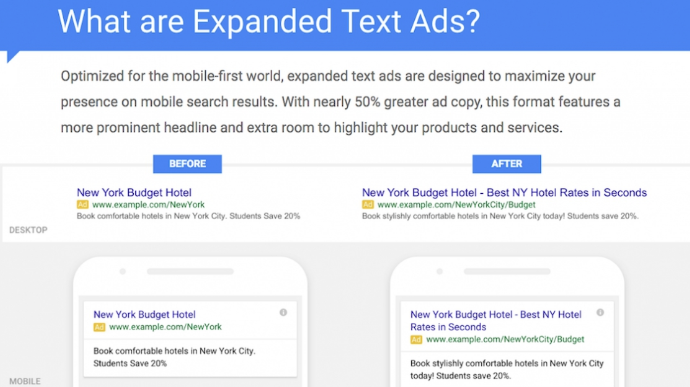
Expanded Text Ads are comprised of the following elements:
- Headline: Two 30 character headline fields, which can appear side by side or on separate lines, depending on the size of a user’s screen.
- Description: One 80 character field, within which you should try to highlight the core reasons prospects should engage with your ad over others.
- Destination URL: This is the landing page users will be sent through to, so it is worth spending time testing different landing pages to see which perform best for specific queries. The destination URL will be tied directly to your Quality Score, which we will get to in the next section.
These fields will be displayed as follows within the AdWords interface:
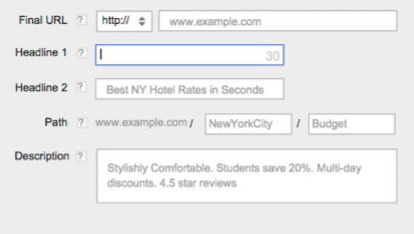
A best practice in this area is to create 2 or 3 ad copy variations and test the effectiveness of each in a controlled environment.
Google has also created a helpful walk-through to help users navigate the platform as they create their ads:
Ad extensions
Advertisers have access to a wide variety of extensions, allowing them to highlight offers, benefits, or unique selling points to their intended audience. These also bring the advantage of taking up more space on search results pages, which can have a positive effect on click-through rate.
As we can see in the example below for the query [car insurance], advertisers are making the most of these new formats to take up as much valuable real estate as possible.
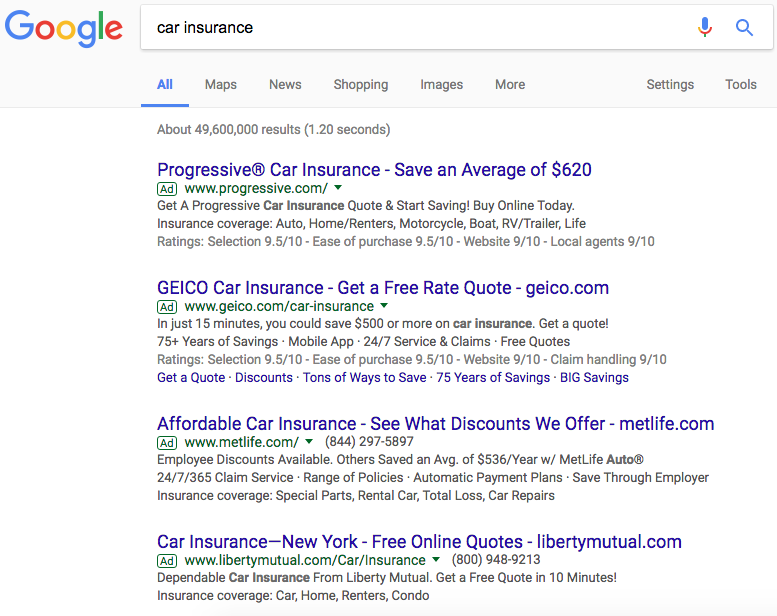
We won’t go into detail on ad extensions within this guide, but it is worth knowing that some appear automatically while others require input from advertisers before they show. You can read more here about the list of possible extensions.
Stage 4: Setting up ad groups and campaigns
We are now ready to start categorizing our keywords and ads into ad groups.
This can be achieved by separating out your products and services and creating an ad group for each. If we go back to our sleepwear example, we can illustrate a clear and logical approach for achieving this.
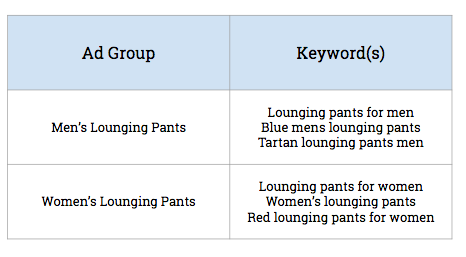 Each of these ad groups will have 2-3 ad copy variations, which can be updated on an ongoing basis as performance data arrives in the account. Each keyword, of course, can be set to the match types outlined above.
Each of these ad groups will have 2-3 ad copy variations, which can be updated on an ongoing basis as performance data arrives in the account. Each keyword, of course, can be set to the match types outlined above.
After I have tested out this product, I may decide to branch out into the pajama market. This is where we need to introduce the concept of campaigns, which sit at a level above both keywords and ad groups.
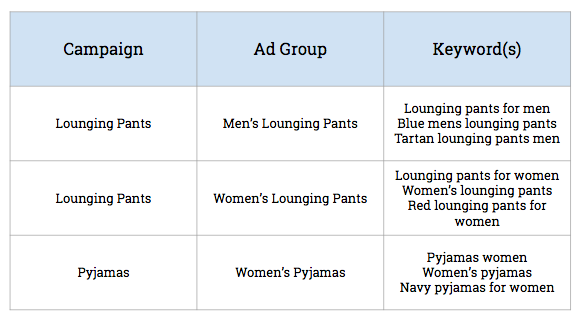
In a nutshell: keywords make up ad groups, and ad groups make up campaigns.
There is no obvious reward for starting with a huge array of ad groups; in fact, this lessens your level of control over performance. When getting set up, it is best to begin with a smaller sub-set of core products as this will help performance and allow you to learn from the data much faster.
Some marketers even prefer to isolate keywords into their own ad groups, if they are particularly profitable. This strategy brings a lot more control, but it is labor-intensive and restricts the amount of data that can be used for optimization within the ad group.
Stage 5: The fundamentals of AdWords bidding
The AdWords auction dictates how much you pay for each action and in which position your ad will show for the selected keywords.
First of all, it is important to know that AdWords operates as a sealed, second-price auction. This is explained clearly by Cornell University:
“The auction is a sealed-bid auction because advertisers do not know what other advertisers are bidding. The highest bidder wins the auction and gets their advertisement placed on specific pages for specific users, but pays the price of the second highest bidder plus $0.01. The $0.01 is to differentiate the highest bidder from the second highest bidder and to allow the highest advertiser to outbid the next highest bid. This type of auction awards the advertiser with the highest bid but sells the advertisement slot to the highest advertiser at the price of the second highest bid.”
Therefore, what you bid is not always what you pay. A second consideration is that budgets are set as a daily limit; however, Google has recently decided to allow accounts to spend up to double this amount each day as long as they are still hitting their campaign targets.
This is evened out over the course of a month, and Google will never charge advertisers more than 30.4 (the average number of days in a month) times their daily budget. So if your account spends double the daily limit on a frequent basis early in the month, you could max out the budget rather quickly.
Luckily, there is a very helpful script that will allow you to keep some control over this.
Now, when it comes to bidding, we can split out the two main options as automated or manual.
Automated Bidding
Google uses a range of advanced machine learning technologies and rule-based automation to deliver maximum value to advertisers in its auctions. We can therefore tell Google what our objective is, how much we are willing to pay to achieve it, and let the algorithms do the bidding on our behalf.

That makes automated bidding sound appealing, but there are enough cautionary tales in the industry to suggest it must be approached with some reservation.
Ceding control to Google altogether can lead to very costly campaigns and, while setting a sensible ceiling on maximum bids can help, automated bidding can still lead to inefficient spend. Machine learning systems feed off data and learn from feedback, which means budget can be spent in a wide range of areas to gain this knowledge.
Manual bidding
For a beginner, manual bidding is a great way to start. This option provides control, quick feedback, and the ability to adjust bids quickly based on performance. Although it gets more difficult to stick with manual bidding as an account increases in size and complexity, nascent accounts with a small set of ad groups will benefit from this approach.
Google has also added the option to adjust bids based on a user’s device type. This welcome feature means marketers can increase their bids for specific queries on a mobile device, for example, if they know that this device type typically converts better than desktop. This is reflective of user behavior, as people tend to use their mobile and desktop for different purposes.
Quality score
Quality Score is a fundamental aspect of Google AdWords bidding, as it will dictate how much a brand pays for clicks. The intention behind Quality Score is simple: Google wants to ensure that relevant ads show against its searches and also wants to deter low-quality websites from manipulating the system to gain high ranking positions.
AdWords depends on its high quantity of searches, after all, so Google needs to ensure users have a positive searching experience or they may take their business elsewhere.
The exact formula behind Quality Score is not publicly known, but we can make some safe assumptions. The score is on a scale from 1 to 10, with 1 being given to irrelevant ads and landing pages, and 10 awarded to brands that match the user’s intent with a relevant ad and a great landing page experience.
Quality Score is calculated at a keyword level, so you could even see different scores within the same ad group. Again, there is plenty of room for experimentation and it is worth the work, as a high Quality Score can make your budget go a lot further.
Wordstream created a helpful image to illustrate how this works:
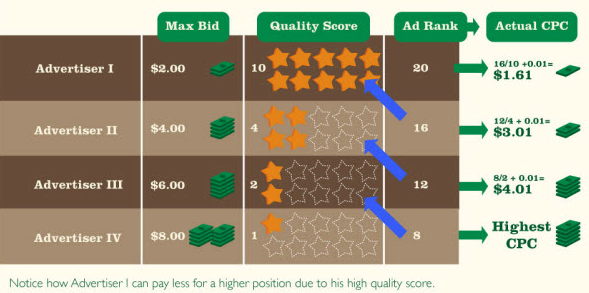
Ad Rank is explained in more detail here, but suffice to say this metric determines which position your ads will appear in on search results pages.
Google recently added a long-awaited feature that allows advertisers to view historical Quality Score, which now allows us to view any positive or negative trends over time. There is plenty more information on Historical Quality Score in this thorough guide.
Stage 6: Reviewing and optimizing performance
To get the best possible results from Google AdWords, marketers need to keep a close eye on their performance and be prepared to make adjustments. There are four metrics in particular to keep abreast of, which can be segmented by dimensions such as device type, demographic factors, or location.
Click-through rate (CTR): Clicks/Impressions
Conversion rate (CVR): Conversions/Clicks
Cost-per-click (CPC): Spend/Clicks
Cost-per-acquisition (CPA): Spend/Conversions
The steps outlined above will get your AdWords campaign up and running with the right foundations in place. There is a huge amount more to this platform and advertisers are rewarded for investing the time in more advanced features.
However, this all starts with the basics and as long as marketers monitor performance and are open to new strategies, the more complex pieces will naturally fall into place over time.
Clark Boyd is a freelance digital marketing consultant and a contributor to Search Engine Watch.
Want to stay on top of the latest search trends?
Get top insights and news from our search experts.
This content was originally published here.